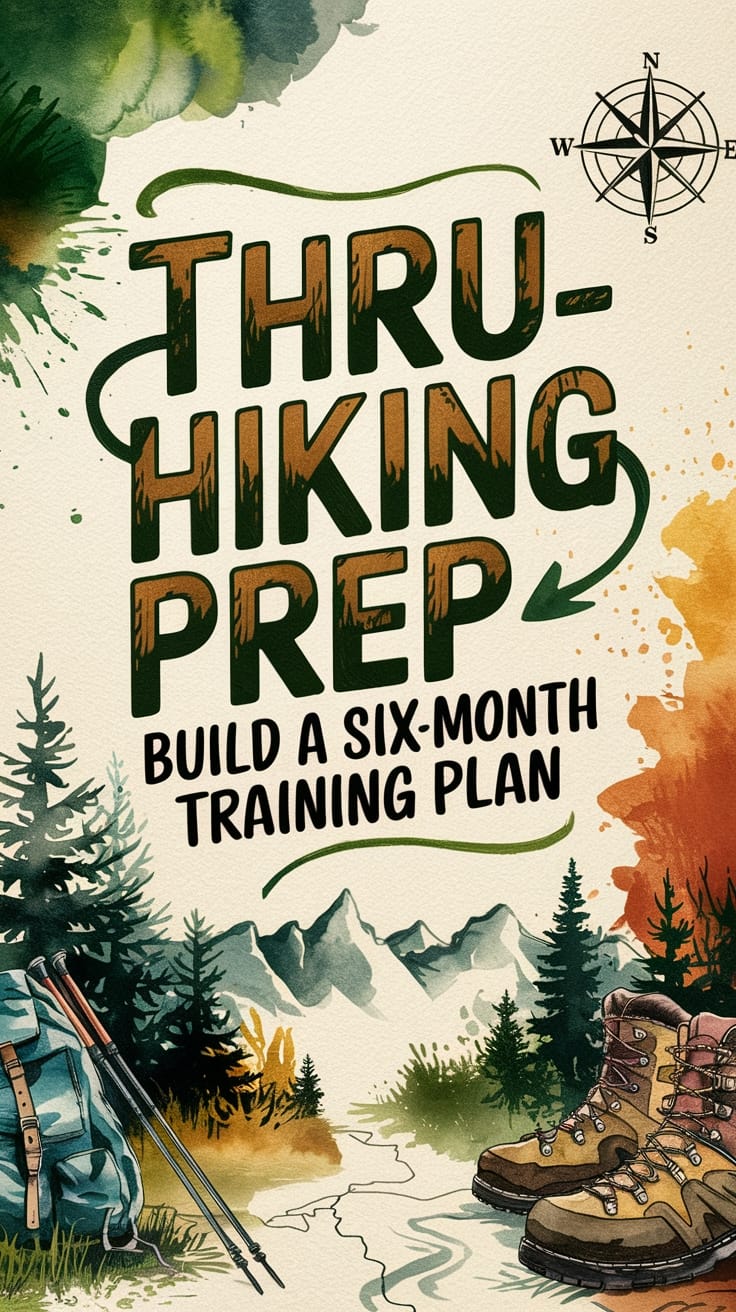Are you thinking about thru-hiking? It's a tough job, but somebody has to do it! If you're looking for guidance on training for thru-hiking, this article is the perfect place to start.
After reading this post, you'll have six months of plans to help prepare your body and mind for a successful hike.
Building a good plan to help maximize your preparation time is vital to your long-term success on the trail, helping you to avoid injuries and allowing you the strength and conditioning to hike all day without getting wiped out and needing to zero more frequently.
This is not a one-time thing, and training for long-distance hiking has to happen for at least six months before you're ready.
The Importance of Proper Thru-Hike Training
Training helps you avoid discomfort or injury that could damage your big adventure or even derail it altogether.
The Appalachian Trail Conservancy reports that only one in four hikers make it to Mount Katahdin to complete a successful thru-hike of the AT, listing injuries as among the most common reasons they quit.
This means you need to condition more than just your muscles and heart with aerobic exercises like treadmill and elliptical training for hiking work and strength-building through weight lifting to help reduce injury risks.
Since many thru-hikers will end up carrying a moderate to heavy pack up and down steep trails this will help in preventing back pain and ensure your body is best prepared for consistent movements like steps, hills, and more.

Comprehensive Thru-Hike Training: Physical and Mental Preparation
This is a mixture of mental preparation along with physical prep that ensures you are ready for an arduous adventure that will tax your will, and fortitude and physically push you to your limits.
You want to start with your three core needs: flexibility, muscle, and cardio. These needs should be addressed and performed for at least two to three days a week for maximum benefits.
Flexibility helps make sure your body is limber and pliable to movements that may not always be too natural to our urban environment, strength will help with your uphill and then cardio allows you to go longer and harder each day.
You want your workouts to last between 30-60 minutes each time, with the amount depending on what you are trying to accomplish with targeted work.
Since I am not a physician, before starting any specific training program, make sure you speak to medical professionals and get checked out to make sure it isn't a danger to your health and if so they can help with a modified plan.

Enhancing Flexibility for Thru-Hiking: The Role of Yoga
A much-overlooked area of fitness for the outdoors and hiking, in general, is flexibility and being pliable.
When we are outside, or even in our daily lives with many different activities and jobs to do it can be hard enough just getting all those things done without adding on extra tasks that require a higher level range of motion.
When you have better overall mobility throughout your body then not only will these other external movements become easier but so too does everything else internally like breathing deeper into the lungs which means more oxygen flowing through blood vessels bringing nutrients up from the feet towards the heart where circulation improves as well.

Strength Training for Thru-Hikers: Weights vs. Bodyweight Exercises
For physical training for a thru hike, you should focus on lower weight and more reps to hit the endurance fibers in the muscles, which will, in turn, build muscle mass and overall power.
Focusing on this helps you to build up these vital muscles which are used to help you maintain your balance, which is called into need lots, especially during those long days and months on a thru-hike.
Performing a proper fitness plan prior with muscle building helps decrease the likelihood of common overuse injuries as well as limiting the chances of being impacted by those types of injuries.
These can show up in issues like knee and ankle pain, shin splints, and plantar fasciitis that can force you off the trail for a short period to permanently for the season because they can take so long to heal.

Cardio Training for Thru-Hikers: Hiking, Stair Climbing, and Treadmill Workouts
For cardio, I think it is clear, the better your cardiovascular system before you start on the trail the easier it will be.
I recommend hiking as your primary cardio training unless you live in the flatlands like me in Texas. Then like me, you should look to supplement with at least a high-incline treadmill (15% inclines) and a stair climber for more vertical work.
If you don't have access to a stair climber, then find a building or parking garage around you that has floors of stairs and start climbing and descending.
As for the treadmill, you can also work on a low incline to work on sheer endurance work and try to work yourself up to 12-20 miles per day as this will set you up to annihilate a trail with built fitness prior.
LISS Training: Building Endurance for Long-Distance Hiking
This is excellent training for hiking as it is focused on teaching your body to spend a long period constantly outputting effort moving without reaching exhaustion and tiring out.
Low-Intensity Steady State workouts are going to be perfect if your goal is straight endurance and not to build speed or increase your overall power output, using a quality elliptical can help build up this long-duration endurance.
There will still be a need for some ramping up as you do want your intensity to get high, for many this could be as high as a 15% incline, in order to drive the body into the lactic acid generating low-intensity work zone of approximately 60% effort.
HIIT for Thru-Hikers: Benefits and Limitations
While popular within fitness circles HIIT training is not always the best way to train for long distance backpacking.
One of the major reasons is that High-Intensity Interval Training training has a tendency not only to drive lactic acid build-up but also to create an oxygen debt. These are typically counterproductive when you are backpacking from place to place and often times altitude level as well on your thru-hike.
Instead, this can be used as a tool to help you build up but I would refrain from doing it more frequently than once a week as longer, more sustained work is what you need to be able to manage for multi-week trails.
Mastering Elevation Changes: Preparing for Trail Terrain
The final part of fitness preparation is hiking while gaining and losing elevation. The purpose is to replicate conditions on the trail you have chosen to hike to better prepare.
So if you are planning for the Appalachian Trail, you wouldn't need to get as much high elevation training as if you were to be preparing for the Sierras on the Pacific Crest Trail. While you gain more elevation oerall on the A.T. the P.C.T has much higher peaks in general.
Being better prepared for these consistent changes will ensure you survive and thrive instead of gassing out and needing to stop all the time. On a trail like the A.T. you have lots of PUDS, or pointless ups and downs, where you go up 2000 feet and then down 2000 feet and similar. You will want to be physically prepared for the rollercoaster.
If you have not done enough elevation gain and loss then it will be easy to get altitude sickness on the trail, or your heart rate may stay too high when going up a mountain.
If you have not done enough elevation gain and loss then it will be easy to get altitude sickness on the trail, or your heart rate may stay too high when going up a mountain.
You can do this by hiking in areas around where you planning on thru-hiking, this way you get to build up beforehand so you are healthy and ready once on the trail for real.
Mental Preparation: Cultivating a Thru-Hiker's Mindset
While almost everyone will focus heavily on the physical the mental game is far more important to your overall successful thru-hike than you may realize.
Many who start will quit based solely on their mental ability and lacking the preparation required. You see this on shows like Naked and Afraid, where many choose to quit due to missing family and mental exhaustion and not due to physical efforts.
To be successful you must make sure you fully grasp your reason, the why behind you deciding to thru-hike to increase your mental resolve. The last part is learning to enjoy being alone, as for most of us this alone is an incredibly frightening issue but it is nearly essential for success.
Finding Your 'Why': Motivation for Thru-Hiking Success
One key you must think about and really come to grasps with is understanding your personal reason for thru-hiking, what is driving you to take on this huge and daunting task and keeps you on point when everything goes wrong?
For many of us, it may be a base need to want more time alone, fewer distractions, or a big life change where you need to possibly rediscover yourself and what you hold important personally.
A long trek allows them to get away and be a means of therapy from past trauma while others may just be yearning for a life-altering adventure in their life.
Knowing and having this personal "why" in your mind will help keep you from quitting the trail when it gets hard and things don't work. This is your rock on your trek and if you don't have it in your heart you may fail.
Embracing Solitude: Mental Training for Solo Thru-Hiking
For hikers it is typically well understood that you may spend some decent legs of a day or longer without any other interaction with other people, the further away from cities this is kind of expected.
This doesn't mean you won't see people nor interact with people but it means you need to know how YOU will handle less human communications as this can cause drive a hiker to quit when they find they are more a day or family hiker.
Instead, what you want to learn is why it is ok to just exist within your own head and to enjoy that almost limitless access to yourself, without interruptions normally experienced in life.
Physical Conditioning: Preparing Your Body for Thru-Hiking Challenges
You must focus pre-trail on building up your overall body fitness as you need to be able to work your body harder than it has probably ever worked while you hike for months on end without failure.
Pushing your body will end in issues without proper build-up before, but not just your legs need to be focused on. You need to build up your toes and feet, work on aerobic style cardio, resistance training, and stretches to help round out overall peak fitness performance.
Foot Care and Conditioning for Thru-Hikers
Your feet are more than likely your biggest chance for success and your worst enemy in leading to a complete failure on your thru-hike while also being the most overlooked.
You want to focus on working out and building up the skin and ligament strength within your foot as it will be getting an incredibly large workout consistently walking over uneven surfaces.
You can work on this foot toughening and ligament strength on any sand you can find, the deeper and longer the better to help push and work through building up those feet to be durable for the long haul.
Many thru-hikers haven't walked in the boots or shoes they plan to start the trail with. This can be dangerous as they then aren't broken in, and you can't know how they fit and how your feet will feel.
Instead, you want to make sure you have walked in your shoes and socks plenty before starting your thru-hike to make sure you know how they'll react and that all gear is well broken in prior to beginning.
It is important to note that on a thru-hike there will be days in wet and soaked socks and shoes, in fact, far more than you will acknowledge pre-trail. Shakedown hikes where you cross streams and soak your shoes and socks are critical to get adjusted and learn how to make adjustments.
This may seem over the top but wet feet and shoes versus dry ones make a large difference in your life on the trail, and knowing how your feet will survive 8 hours in wet, damp shoes is a good way to prepare yourself for the inevitability of the trail.
Boosting Cardiovascular Endurance for Long-Distance Hiking
One of the most essential things for any hikers is to have a strong cardiovascular system, you will need your heart pumping hard but being able to recover fast.
If you don't have any real hiking areas around, you will want to work out on machines and on sidewalks and preferably some parks in the area to get some path walking at a minimum.
If you only have time for machines, then you should focus on the treadmill at a 15-degree incline and stairclimber to build the most power in your legs that will hold up to the upcoming mountains.
Resistance Training for Thru-Hikers: Building Functional Strength
Resistance training is helpful to your overall strength but limited in overall benefits for a thru-hike, it is important to understand that muscle mass does not equate to hiking power and strength.
Lifting weights builds up your endurance but doesn't do much for the legs specifically, it can be helpful to add some in if you are looking for more upper body strength as well but it's just more calories and weight on you on the trail.
Performing isometric exercises like push-ups and planks helps build core muscles. This in turn, will help support a heavier pack while building functional stamina.
It's important to perform these routines three times per week preferably before cardio workouts for maximum effect.

Stretching Techniques for Injury Prevention and Recovery on the Trail
One of the other least focused things that can help you become healthier and more resilient on the trail is to focus on stretching out the muscles you worked hard on during the day.
It's well understood that you should stretch pre and post workout, but many fail to do this during their hikes. Many stretches can be done on trail while taking a break or after camp is setup for the night focused on your calves and hamstrings.
First thing in the morning, you can do dynamic stretches before starting your hike with a few rounds of "the running man" and "high knees." Then, once you are done for the day, you can perform static stretches on your sleeping pad.
People don't help themselves by skipping stretching their muscles after hiking hard all day. The best way to avoid soreness later on from hiking would be to focus on stretching those worked muscles so they don't give out too quickly during those long days.
Adding stretches could help you become healthier and more resilient while taking a break or setting up camp for the night focused around your calves and hamstrings, which will do wonders.
Mastering the Art of Thru-Hiking Preparation
Embarking on a thru-hike is more than just a physical journey—it's a transformative experience that demands comprehensive preparation. As we've explored, successful thru-hiking hinges on three crucial pillars:
- Physical Readiness: A balanced regimen of cardiovascular training, strength building, and flexibility work prepares your body for the rigors of long-distance hiking.
- Mental Fortitude: Understanding your motivation, embracing solitude, and developing resilience are key to overcoming the psychological challenges of the trail.
- Technical Skills: From foot care to gear selection, mastering the practical aspects of trail life is essential for a smooth journey.
Remember, the path to a successful thru-hike begins long before you take your first step on the trail. By dedicating time to thorough preparation, you're not just increasing your chances of completing your hike—you're setting the stage for a richer, more rewarding adventure.
So, lace up your boots, start your training, and begin the mental preparation. Your thru-hiking dream is within reach. The trail awaits—are you ready to answer its call?







